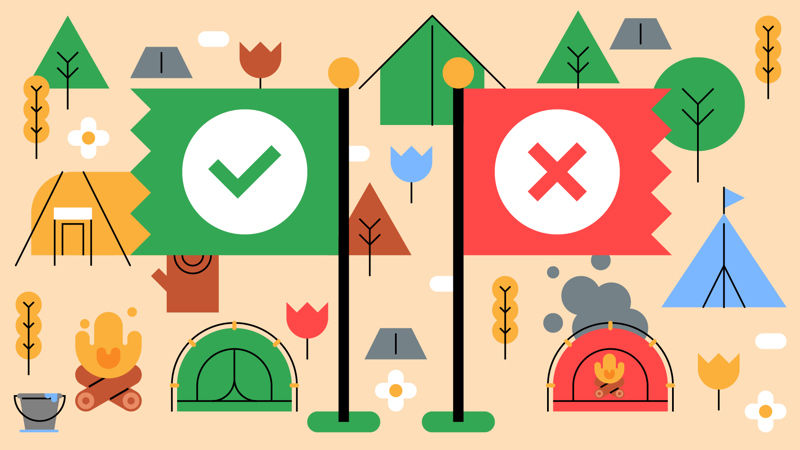
Learn the dos and don’ts of camping
You’ll need
- Pens or pencils
- Scrap paper
Before you begin
- Use the safety checklist to help you plan and risk assess your activity. Additional help to carry out your risk assessment, including examples.
- Make sure all young people and adults involved in the activity know how to take part safely.
- Make sure you’ll have enough adult helpers. You may need some parents and carers to help if you’re short on helpers.
Running the activity
- Gather everyone together and tell them you’re going to learn more about what to do when you go camping.
- Ask everyone to get into teams. Each team should find a space.
- Give each team a pen and some paper. You could also use a whiteboard.
- An adult or young leader should read out a ‘do’ or a ‘don’t’ from the ‘fill in the blanks’ sheet. Each statement is missing a word – the person reading should say ‘blank’ to make it obvious where the gap is.
- When they’ve heard the statement, each team should decide what they think the missing word is, and write it on their scrap paper.
- Teams should then reveal or hand in their answer. Any team that chose the right word should get a point.
- The person reading should explain why you should (or shouldn’t!) do the statement.
- Keep playing using another statement, until everyone’s confident that they know what (not) to do when camping.
- The winning team is the one with the most points.
- To make this game more active, you could have several buckets, each representing a different answer. The answers could be on a piece of paper that’s attached to or placed underneath the bucket. Teams can then choose their answer by running or moving over and putting a ball in the bucket they think it is.
- You could also play this individually as a corner’s based game, with each corner being assigned a possible answer. People then move to the corner they think is the right answer.
Reflection
This game helped you to value the outdoors. Do you enjoy being outside pitching and striking tents? Do you feel comfortable when you’re camping? Were any of the statements about making sure you respected and took care of the outdoors?
This game was also a chance to try new things. Have you been camping before? Have you had a go at pitching and striking different types of tents? Did you know all of the right answers? Do you think you’d find it easier to try camping again now you know more about what to do?
Safety
All activities must be safely managed. You must complete a thorough risk assessment and take appropriate steps to reduce risk. Use the safety checklist to help you plan and risk assess your activity. Always get approval for the activity, and have suitable supervision and an InTouch process.
- Active games
The game area should be free of hazards. Explain the rules of the game clearly and have a clear way to communicate that the game must stop when needed. Take a look at our guidance on running active games safely.
- You could make your own statements – will you make them simpler or harder?
- To make this activity easier, you could also use actions to represent different answers and the team all has to do the same action.
- To make this activity easier, you could talk through the whole list before you start, so everyone gets a chance to understand what is (and isn’t) good practice when camping.
- This game can be played sitting or standing, either on the floor or on chairs. Make sure to adapt to whichever way works best for everyone and make sure any actions are things everyone can do.
- If anyone struggles with writing down the answer, a young leader could help them.
- People can move at their own pace, so you don’t need to make it competitive unless it works for everyone.
- Some people may find these activities noisy, especially if the space echoes. You could have a noise level warning system to help everyone be reminded of the noise levels. The person could wear ear defenders, or you could run the game over a larger space to reduce the noise. Shutting doors and windows can help to reduce external sounds if you're indoors.
All Scout activities should be inclusive and accessible.
